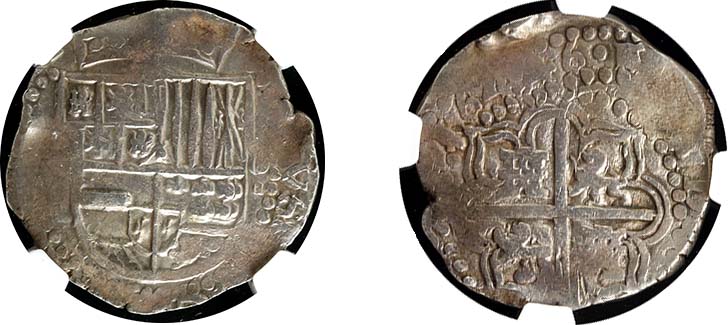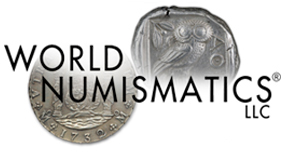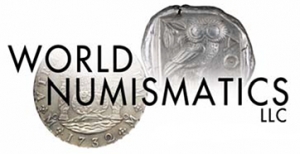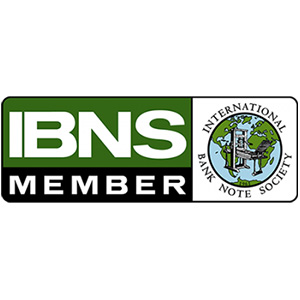Succinct History of Cobs
By Carlos Jara

Spanish colonial cob coinage is among the most popular series of the New World and contains many of the legendary coins herein. Cob coins were effectively the first coins minted in the Americas by the Spanish conquering authorities and issued by various mints for a period that encompassed more than 200 years starting in 1536 when the Mexico City mint issued its first coins.
The cob coinage characteristics
While the first specimens of the Mexico City, Lima and Potosi mint are rather carefully struck on very roundish planchets – and thus sometimes not even considered as “proper” cobs – the quality of the coins of all these mints soon started deteriorating as can be seen through the examples depicted below (note that the coins struck at the Cartagena and Santa Fe mints in Colombia were always cruder than those of other contemporary mints while the short-lived Santo Domingo and Panama mints, both already inactive by 1600, do not span a long enough period to illustrate the aforementioned fact of progressively deteriorating coins). The later, irregularly shaped coins are the ones normally associated with the cob designation and their method of manufacture is often considered to be at the origin of the “cob” name: slices were cut from the end of a silver or gold bar (refined to the proper fineness) and then adjusted to the prescribed proper weight by hand cutting with scissors or chisels. The obtained planchet was then placed on a fixed die to impress the design by hand blows inflicted over the upper mobile die. Multiple strikings are a common occurrence in the series and most often seen in the highest denominations which is logical since larger planchets necessitated stronger and often multiple blows to obtain the desired impression. The most accepted etymology for the “cob” moniker is the Spanish “cabo de barra” or “end of bar” which is thought to refer to the aforementioned planchets obtained from the end (“cabo” in Spanish) of the metal bars.
These “regular” series cobs – hand struck over irregular planchets – are cruder by nature when compared to machine milled coins, yet it is that very characteristic that explains most of their charm and current popularity. Even though they can be sometimes challenging to correctly attribute and identify – since the aforementioned imperfect planchets and strike often do not allow a full rendition of the legends – they are nevertheless a very romantic issue, linked to pirates, Spanish conquerors and the like. The rare and strikingly beautiful “galanos” or “royal” round presentation pieces represent the pinnacle of the technical capabilities of the mints that issued them and are naturally much in demand. A definitive explanation for their manufacture – which involved carefully and specially produced round planchets and often also special dies – has not been presented yet it is clear that they were pieces minted for a specific reason.
Cobs circulated profusely in word trade, albeit they were sometimes melted in order to strike local coins. They were naturally legal tender in the Spanish dominions of the Americas and then later in US territories. The wide scope of territories in which they circulated helps to explain for example the long lasting consequences of the Potosi mint scandal of 1650-1652, where a long lasting fraud committed by mint officials spanning more than 20 years was uncovered. Culprits were given “exemplary†punishment – a long suffering and gruesome death – and, more importantly for us numismatists, the designs of the coins were radically altered after a transitional period which lasted 2 years and contains many rarities in the series. Cobs were finally replaced by the milled coins of the pillar type design. These new coins were clearly a technical improvement since coin press-struck over round planchets with a leaf-patterned edge design that prevented clipping. Their mintage was gradually implemented in the various Spanish Colonial mints starting with Mexico in 1732. Lima and Santiago followed in 1751, Nuevo Reino in 1753, Guatemala in 1754 and Potosi in 1767 although cobs coins were also struck at that mint until 1773. Nevertheless, cob coins were still legal tender in many of the Latin American independent republics in the later part of the 19th century, and it is a telling factor that most of the provisional coinages of said young republics in the 1812-1825 period were issues that intended to imitate the Spanish colonial cobs which represented the core of the circulating media at the time. These include the Caracas early imitation cobs, the Argentine Rioxa issues of 1821-1822 and the Central American issues of 1823-1825.
Our current inventory includes a number of rare items and many desirable specimens of these popular series. Highlights include very rare “Royal” 8 Reales specimens of the 1659 Star of Lima and 1727 Potosi Louis 1st issues, a choice Potosi 1654 transitional ½ Real, unusually attractive examples of the crowned-shield type Potosi 2 Reales, and a good run of the very scarce cuartilla (1/4 Real) series. The latter include the sole representative of a previously unknown Potosi type struck just prior to the aforementioned scandal of that mint and two attractive examples of the very rare Lima assayer “I” series. These three specimens represent wonderful opportunities for the advanced collector of these elusive series since only 7 combined examples of those two types are currently confirmed.








